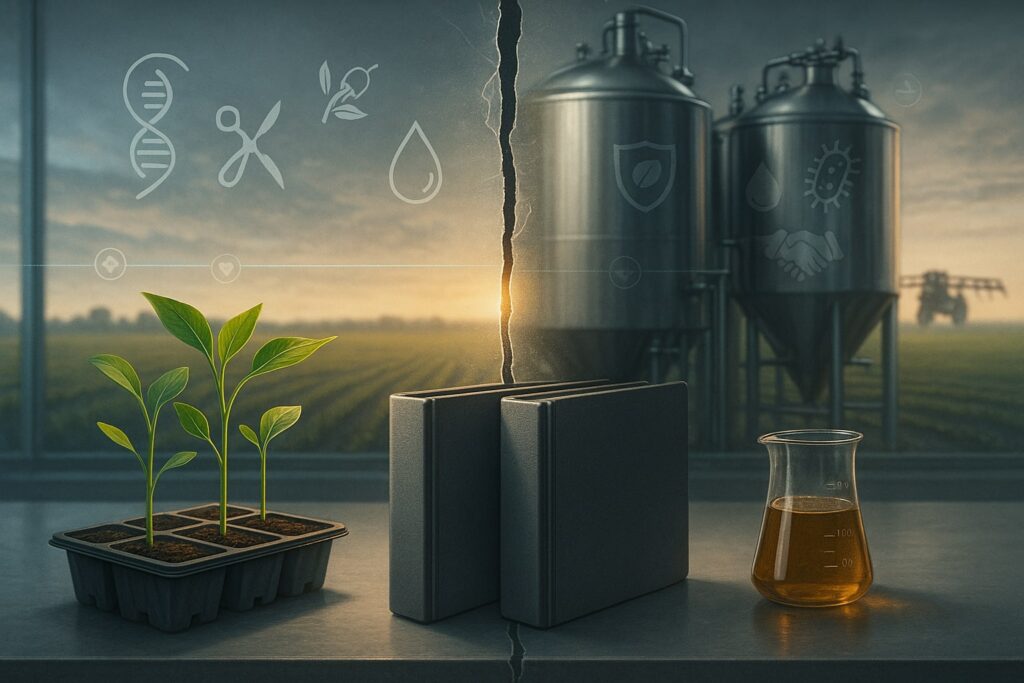Announced October 1, 2025, Corteva will split its seed and pesticide businesses into two publicly listed companies, finishing in H2 2026. The carve-out is pitched as a clean way to sharpen strategy and capital allocation. It could also redraw the deal map for ag-biotech and biologicals start-ups—shifting who writes the cheques, who licenses what, and on what timelines.
Table of Contents
ToggleWhat’s happening—and why it matters now
Corteva’s board approved a tax-free spin: “SpinCo” will house the Seed business (Pioneer among other brands); “New Corteva” will contain Crop Protection. Management assignments are already telegraphed—CEO Chuck Magro to lead the seed company; Chair Greg Page to chair the crop-protection firm. Management says the markets for seeds and crop protection have “diverged,” and a split lets each business tune its own R&D and M&A. Completion is targeted for the second half of 2026.
The timing lands in a pivotal product cycle. In 2024, seeds generated roughly 57% of Corteva’s $16.9bn net sales, crop protection 43%; investors have lately fretted about the company’s ability to juggle both cycles amid price pressure in chemicals and a choppy macro. A split isolates the growthier seed genetics from the more cyclical chemistries—and it sets up two different appetites for partnerships and acquisitions.
The under-reported angle: a new market for alliances
1) Seedco as a licensing magnet for next-gen genetics
The seed entity will live or die by a multi-year pipeline of traits, hybrid platforms (including hybrid wheat), and gene-edited products. Expect it to license more aggressively and write earlier-stage option deals—especially as UK precision-breeding rules fully switch on in 2025 and EU “NGT” legislation advances, de-risking European field deployment for certain edits. That regulatory clarity is currency for start-ups.
Corteva already operates an open licensing stance on CRISPR with Broad Institute; Simplot and public institutions such as IRRI have taken licenses. In 2024 it also formed a JV with Pairwise, and invested $25m via its Corteva Catalyst platform—useful tells on the seed group’s partnership posture.
What that means for founders: pitch seed-trait packages with clear regulatory pathways (UK first movers; EU “NGT1” candidates), out-licensing economics, and stackability with existing Corteva traits. Bring proof on field performance and IP freedom-to-operate; Seedco will prize platforms that shorten time-to-cultivar.
2) Crop-protectionco as a consolidator of biologicals — at the right price
Corteva spent 2022–23 buying scale in biologicals (Stoller for $1.2bn; Symborg for $370m). As a focused crop-protection entity, it can double-down on fermentation, pheromones, and bio-stimulants—but with harsher hurdle rates and tight supply-chain discipline. Rivals are already active: Syngenta integrated Valagro; FMC bought BioPhero for $200m, targeting $1bn pheromone revenues by 2030. Expect New Corteva to compete on differentiation + distribution, not volume for volume’s sake.
Independent forecasts suggest biologicals will roughly double by the early 2030s; corporate guidance calls the segment the fastest-growing in crop protection. Translation: bio-start-ups with repeatable field efficacy, manufacturing cost curves, and MRV-ready data move to the front of the queue.
What that means for founders: push cost of goods and formulation stability as hard as efficacy, and come prepared with co-manufacturing routes. Show how your product co-sells through existing Corteva channels (geography, crop) and under new residue/tolerance regimes.

The synergy question everyone else will miss: Enlist after the split
The integrated Enlist system (Enlist E3® soybean trait + Enlist herbicides) has been a poster child for seed-chemistry coupling. Analysts have already flagged the risk of “lost synergies” if seeds and chemistry sit in different boards and bonus plans. Two counterpoints:
- The trait and herbicide are already distributed beyond Corteva’s four walls (e.g., Bayer sells soybeans with Enlist E3). That suggests commercial and licensing structures can maintain system-level coherence even under separate cap tables.
- The post-spin seed and crop-protection companies will still have every incentive to contract with each other—especially where stewardship and resistance management require tight alignment. The real friction isn’t technical; it’s governance (pricing, promotions, and channel priorities).
Follow the budgets: who spends on what
Corteva spent about $1.4bn on R&D in 2024. Post-split, expect Seedco to skew toward trait discovery, gene editing, and breeding logistics, and New Corteva to bias chemistry optimization, fermentation scale-up and bio-formulations—with different time horizons and acquisition math. Start-ups should tune pitches accordingly.
Segment economics to watch:
- Seed: higher structural margins, long cycle times, sticky farmer loyalty; valuation levers include IP royalty streams and out-licensing.
- Crop Protection: more cyclical pricing; upside from raw material deflation and mix (moving toward differentiated actives and biologicals). Recent quarterly disclosures show how quickly margins swing with price/mix and currencies.
The start-up scorecard: who should knock on which door?
Best fit for Seedco (SpinCo):
- Gene-edited traits with clear UK/EU pathways (NGT categories), hybrid wheat, nitrogen-use traits, stress tolerance; platforms enabling faster breeding cycles.
Best fit for New Corteva (Crop Protection):
- Biologicals with defensible COGS, pheromone mating disruption at field-scale, bio-fungicides with shelf-life data, adjacent chemistries that plug into Corteva’s distribution. Benchmarks: Stoller/Symborg (Corteva), Valagro (Syngenta), BioPhero (FMC).
Cross-cutting:
- MRV-grade data: time-stamped field trials, third-party analytics; this matters for both carbon-claims scrutiny and CPG sourcing audits.
- IP clarity: freedom to operate against Corteva/Broad CRISPR estates; demonstrate how you’ll navigate pooled licenses.
Risks and execution realities
- Dis-synergies: Less “system” bundling at the field edge (trait + tank mix + financing) could appear in year one. Watch how the two boards codify intercompany agreements for integrated offers in soy and corn.
- Spin friction: Separation costs, management distraction, and SEC/Form-10 timelines can slow deals; management itself warns timing and terms may change.
- Macro & policy: Currency swings and tariff noise have buffeted inputs; meanwhile, EU gene-editing rules are still in trilogue sausage-making—timelines matter for EU-facing trait start-ups.
Data box: the split at a glance
- Structure: Tax-free spin of Seed (“SpinCo”); Crop Protection remains “New Corteva.” Target H2 2026 completion.
- Size today: 2024 net sales $16.9bn; ~57% seed / 43% crop protection.
- Pro forma guideposts (company est. 2025): Seed $9.9bn, Crop Protection $7.8bn.
- Leadership: Magro to SeedCo (CEO); Page to Crop-Protectionco (Chair).
- R&D (2024): ~$1.4bn.
What to watch next (signals the market will price fast)
- Form-10 filings: segment-level margin bridges, capital structures, and any transition services for shared systems (supply, IT, data).
- First “new-world” deals: Seedco’s next licensing JV (think Pairwise-like) and New Corteva’s next bio acquisition or fermentation JV.
- Enlist governance: any updates to reseller terms, co-promotion and stewardship—particularly with third-party seed brands carrying Enlist traits.
- EU/UK regulatory clocks: final texts and implementation dates for NGT/precision-breeding rules, which will shape where Seedco launches early.
Bottom line
The split is more than a finance story. It creates two different buyers of innovation with distinct scorecards—one valuing genetic platforms and licensing cash flows, the other hungry for manufacturable biologicals and differentiated chemistries. For founders, the opportunity is to sell the same farm outcome in two languages: yield and breeding velocity to Seedco; COGS and channel fit to New Corteva. If management hits its timetable, the ag-tech deal table just got bigger—and sharper—overnight.




